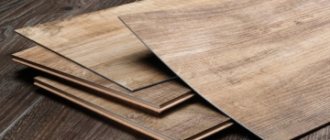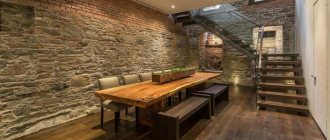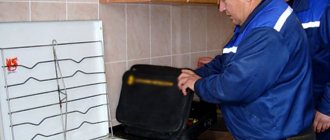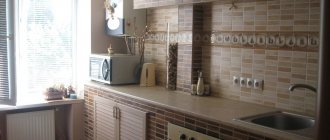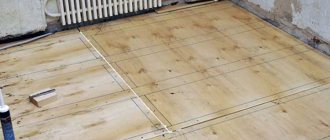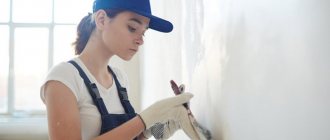Laminate is an excellent decorative floor covering, which has such operational advantages as durability, reliability, high quality, and low cost. But, despite this, the particle board, which is the basis, is highly susceptible to moisture. This negatively affects the safety of using the floor covering, as there is a possibility of mold formation. It is worth noting that all finishing materials based on the use of wood are susceptible to this effect. Mold is microorganisms that are formed during the process of biodegradation. It may be unsafe for humans and can cause diseases such as dermatitis and pneumonia. Let's look at the main reasons for the formation of mold under laminate flooring, how to get rid of it correctly, and the main stages of work.
Coating features
Laminate visually resembles a board or parquet. The parts are joined together using key joint technology (“groove to groove”). After installation, a warm, even coating remains on the floor, which is pleasant to walk on.
The structure of the laminate consists of 90% sawdust. Recycled shavings or crushed wood chips are compressed under high pressure. Glue is used to bind the ingredients to the base. Natural or synthetic resin is used as a fixative. As a result, wood residues acquire:
- strength of natural material;
- additional density;
- improved elasticity.
At the bottom of the laminate there is a thin paper or plastic backing treated with paraffin. The film reliably protects the product from moisture. Boards do not swell or deform when in contact with water. In a multilayer structure, fungus does not grow.
Expert advice:
- For rooms with high loads, we recommend using floor slabs with the maximum level of wear resistance. In commercial premises - less stable slats if traffic is lower.
- Installation using the adhesive method is the longest, but most reliable. When laying castle options, it is important to remove exposure to moisture. The ideal solution is adhesive locks. They are not afraid of water, and the installation technology itself is quite simple.
- The thickness of the board is an indicator of the strength of the tile, not the wear resistance of the product. The thickness of the upper protective layers is responsible for this, but they are rarely indicated on the packaging.
- A 2 mm thick underlay will increase the wear resistance of the floor covering and the strength of the lamellas. It is an excellent protective layer against moisture, the likelihood of mold is less, and also serves as additional sound insulation for the room. It is possible to lay flexible tiles without a backing, but the service life of the tiles will be shorter.
- Unlike conventional flooring, which requires an additional underlay, self-adhesive tiles can be laid on the floor. But pay attention to the preparation of the floor. Especially if you plan to install locking models. The installation technology assumes a perfectly flat floor with a difference of no more than 1 mm per 1 meter. Compared to traditional ones, plastic slats react significantly more strongly to unevenness on the floor. Even a high-quality substrate will not be able to completely remove them.
We strive for each client to know not only the cost of work, but also rough and finishing materials before starting repairs.
Therefore, we have organized a showroom of finishing materials, where you can:
- Look at samples of materials. We have collected 800 types of finishing.
- Select the material according to quality and cost for free together with a professional assembler.
- The fitter will prepare an estimate for the finishing material.
Don’t want to waste your time and just ask the price? We offer to calculate the approximate cost of your repair and get advice by phone:
Hazardous substances in the composition
The flooring consists of 90% natural materials. Wood shavings and sawdust contain resins that are safe for the human body. Questions often arise regarding formaldehyde, which is used to dilute fastening compounds.
It is not the substance itself that is considered toxic, but the vapors released into the room. The product goes into gaseous form as the temperature of the material increases. The health hazards of laminate flooring will appear at 100C. Due to the peculiarities of the climate, in normal conditions the limiting degree rarely occurs in the floor covering.
What are the dangerous substances Source novogen.com.tr
Formaldehyde in small concentrations does not emit toxic fumes. If the manufacturer decides to save money, then to protect the top layer it can increase the volume of the toxic substance. After installing the covering under the “warm floor” system, when heated, such a laminate is harmful to health. The combination of decorative boards with veneered furniture is especially dangerous.
Laying technology
A big plus of vinyl laminate flooring is its ease of installation on the floor. In many ways, it is much simpler than working with conventional laminate; moreover, such serious leveling of the floor surface is not required. But there are several important rules that you need to pay attention to.
Substrate requirements
Since flexible laminate is quite soft, it requires a fairly rigid backing. If this rule is neglected, the floor will turn out to be too soft, it will sag when walking, and the use of locking joints will become impossible, since they will very quickly become loose and breakages will begin.
Giving up the underlay and simply laying PVC laminate on the subfloor is not the best idea.
The substrate acts as heat and sound insulation. Without it, the floors will be very cold, and the sounds of footsteps will constantly be heard by the neighbors below, as well as the details of the life of the neighbors below, if there are any.
The best underlay options for this flooring are cork and extruded polystyrene. They have all the necessary qualities for trouble-free operation and ensuring maximum comfort over time.
Emission classes
Formaldehyde, when converted into gaseous form, emits a pungent odor that irritates the mucous membranes of the eyes and nose. Emission classes are needed to determine the concentration of a substance in a finishing material. The indicator is assigned to the floor covering after testing at high temperature and humidity. The characteristic is denoted by the letter “E”, and the number indicates the amount of astringent ingredients.
E0
The laminate is made from natural resin, safe for human health. The finish contains no formaldehyde. The boards have no temperature restrictions, which allows installation with a “warm floor” system. When heated, the material will not emit toxic gas, which makes it possible to use it indoors for children. High price – lack of raw materials.
Raw materials without hazardous ingredients Source magbo.ru
Vinyl laminate flooring: pros and cons
Completely artificial, but even has an advantage over natural materials: from durability to appearance. Among floor coverings, plastic is the most inert to both sunlight and water, as well as aggressive chemicals. There are simply no materials in PVC tiles that could react.
15 years
maximum service life of vinyl laminate
Vinyl laminate flooring: pros
- Moisture resistant
This is its main advantage. Waterproof vinyl tiles can be used to lay either a kitchen or a bath.
- Has a high level of wear resistance
The material is resistant to abrasion and scratches. Withstands high loads. It is highly durable and suitable for any room. The main thing is to choose the parameters: strength indicators, wear resistance classes and water resistance.
Unlike natural materials (for example, wood), artificial materials that are part of PVC coatings are stable and durable.
- Durable
The average service life of tiles is 7 years. The simplest options are up to 3 years, the most durable are up to 15 years; This is considered the main advantage of vinyl.
- Suitable for "warm floor"
For a modern apartment this is important. Although vinyl laminate flooring is installed using adhesive, some panels are suitable for underfloor heating.
- Many varieties and designs
Many interior designers appreciate this material due to the fact that the tiles imitate almost any surface - stone, wood, concrete... And they are perfect for any interior!
- Easy to install
The individual elements are simply laid in a row and secured using the adhesive method using special adhesives or a locking system.
- Easy to care for
The protective layer of the tile does not require special care products. Unlike parquet or engineered wood, for example. Wet cleaning is enough. Therefore, it is often used in commercial premises.
Vinyl laminate: cons
- Price
Among all floor coverings, vinyl laminate is one of the most expensive per square meter of apartment. But its characteristics + ease of installation and maintenance reduce the significance of this minus.
There are inexpensive ones, but they don't last long. We recommend choosing expensive ones, but from well-known brands. You have a guarantee that you will receive exactly the characteristics that are on the package.
- Repair is not possible
Parquet, boards, tiles and many other coverings can be replaced in sections. Or even renovate the old one. This material is not. Complete replacement.
Comparison with linoleum
Linoleum is still more popular than laminate, so people are hesitant to purchase artificial boards for their homes. The material based on sawdust and synthetic resin causes concern among families with children or those with allergies.
Household linoleum resembles a multi-layer cake. The base of the raw material is made of foamed polyvinyl chloride, which is responsible for the flexibility and strength of the floor covering. The upper decorative tier is made of colored PVC. To prevent the surface from collapsing from mechanical damage and friction, the top is treated with a protective film. As a result, a material up to 20 mm thick is obtained.
Laminate or linoleum Source kaksdelatpol.ru
Both floor coverings contain chemical compounds. If the board contains 90% sawdust, then the linoleum is entirely made of polyvinyl chloride. The decorative design is obtained by foaming during the reaction.
Allergies can be caused by each of the materials. Harm to laminate emission class “E0” is possible due to individual intolerance to the ingredients. For example, birch sawdust in boards is dangerous for people with a reaction to tree pollen. PVC or foaming agents can cause negative consequences.
What is better for housing Source floors.com.ua
Main manufacturing companies
The number of flexible laminate manufacturers is quite large. The reason for this can be attributed to the growing popularity of the material, caused by the solved problem of resistance to water, the overall strength and attractiveness of the material as a coating.
Among the well-known manufacturing companies are :
- Allure Floor (Belgium).
- Art Tile (South Korea).
- Berry Alloc (Belgium).
- Dumafloor (Belgium).
- Hoffmann (Austria).
- Haro (Germany).
- Krono original (Germany).
This list is far from complete, but listing all manufacturers by name will not bring any benefit, since in each case it is necessary to consider in detail this type of material, its characteristics and features.
It is enough to note the large number of flexible laminate manufacturers and the variety of options offered.
IMPORTANT!
The high quality and great popularity of many manufacturers resulted from the appearance of a large number of counterfeits. When choosing a material, you should carefully examine the offered product and check for certificates and certificates of authenticity . One of the signs of counterfeit is the suspiciously low price of high-end products. If in doubt, it is better to refuse the purchase.
How to choose the right one
When purchasing flooring, they take into account the functional purpose of the room in which they plan to use the material. For children, we recommend choosing models with emission class “E0”. In the first years of life, the child will be protected from chemical components in raw materials.
In the bedroom of adults and teenagers, you can safely use E1 laminate. The view is perfect for the living room, kitchen and hallway. In the last two rooms, we recommend taking raw materials with additional protection from moisture and mechanical damage.
How to choose the right Source puerta.com.ua
Information about the ingredients and class of the laminate should be present on the packaging of the flooring. When marked “EPLF”, the buyer is warned that the product complies with European standards. Domestic manufacturers indicate GOST and the emission symbol.
The quality of the laminate is confirmed by the certificate. The document contains information about the manufacturer and recipient country. The paper indicates the degree of fire safety. At the end there is data on the emission class, the limit values of which should not exceed 0.12 mg.
How to choose the right flooring Source proraboff.rf
The laminate is swollen, the reason is the lack of an expansion joint
In general, this is a continuation of the topic about the situation with the laminate flooring resting against the wall. The conditions just change a little.
According to the manufacturers' instructions, the coating can be assembled as a single sheet for a length not exceeding 8-10 meters, depending on the manufacturer. Next, it must be separated by a connecting threshold. This must be done, since each linear meter of a floating floor can breathe by about 1 mm. That is, with a flooring length of 15 meters, during the period when the heating is turned off and on, the coating can expand up to 15 mm. Article about laminate classes.
This is all in theory, but in practice it is somewhat different, since we regularly produce laminate flooring using the floating method. And there have never been any complaints against me or my partner regarding the swollen coating. I think it's a matter of correctly set gaps. But it should be remembered that there is no guarantee for this installation method.
Installation sequence
Work should begin from the far corner of the room, located diagonally opposite the front door. The upper edge of the panels of the first row should be trimmed and laying along the wall should begin with a gap of 3-5 millimeters. Such a seam is necessary in case the material expands when the temperature rises, but if it is not observed, the material may deform at the junction with the wall.
Since the adhesive smart tape protrudes from under the top layer, the panels are placed relative to each other in such a way that each subsequent one lies on the tape of the previous panel. You can glue the panels better if you iron them by hand or with a roller.
If adhesive-based planks are used (without tape), then the coating can be laid out close to the wall. It is enough to remove the protective film and press the panel to the base. The slats must not be allowed to move relative to each other. To ensure that there are no questions about the quality of installation, even the slightest displacement should be promptly eliminated. To do this, the bar is quickly removed and placed in the correct position the second time.
To replicate the aesthetics of traditional laminate flooring, the second and subsequent rows are placed relative to the adjacent ones, offset by approximately 1/3 of the panel length. At a certain point in the row you will have to cut the panel to get a piece of the required length.
It is enough to slightly cut the strip along the width and bend it at the cut point, which will lead to its breaking. If installation is carried out near protruding sections of the wall or around various obstacles, then the plank must first be marked in order to then cut off the unnecessary piece.
How to get rid of mold in the bathroom | Best Methods for Removing Mold
Ugh. Form. It's horrible. It's tenacious. This is an uninvited guest who comes to visit - no matter how rudely you treat him. But, unwittingly, you may be creating the perfect conditions for mold to return: a food source, plenty of moisture, and a pleasant temperature.
"You have to remove one of those three stool legs to keep mold from growing," says Pete Duncanson, director of system development for ServiceMaster Restore. "And it's always easier to prevent than to fix."
If you like warm showers and comfortable thermostat settings, there is little you can do about the temperature that mold likes. But you can get rid of mold and prevent it for good by controlling two other factors: food and moisture. Here's how.
Starve It Out
Mold is a horror movie cliché. It's everywhere. It's alive. It is spread by spores floating in the air. And it can grow on any surface—porcelain, plastic, copper, silicone—as long as that surface is coated with organic matter.
Popular readings
5 Important Tips for Winterizing Your Home in Cold Weather
Home Maintenance Tips
Our checklist for winterizing your home will help you keep your home cozy and safe from winter's cold.
How to Hire a Real Estate Agent—and Be Their Best Client
Buy Sell
If you partner well with the agent you choose, you'll both be happier house hunters.
Can I fire my real estate agent?
Buy sell
Sometimes it just doesn't work out. Here's how to say goodbye when you're unhappy.
“Mold does not live on shower walls, grout or caulk; it actually lives on deposited skin cells and soap residue (which is where your skin cells are),” says Duncanson. So. Gross. So, yes, if you want to get rid of mold, take out the cleaning bucket. There is no way around this. But the good news is that you don't need toxic cleaning products. “Soap and water work great with a little elbow grease,” says Bob Yustevich, director of the National Association of Mold Examiners. But two warnings:
- Do not bleach. Online chat rooms and countless websites may lead you to believe that bleach kills mold. Both experts say this is not true. “Bleach or peroxide will remove the stain, but will not kill the mold,” Duncanson says.
- Don't scratch it. Remember, mold is living (it's ALIVE!) and reproduces through microscopic spores. “If you brush [mold spores] with your hand, they will just fly into the air and look for new places to colonize,” Duncanson says.
What about daily shower sprays? Will they work? They provide some benefit because they help push mold food sources down the drain, Duncanson said. But when performed solo, they will not keep your bathroom clean.
Dry
How? Use an exhaust fan. "It's a good idea to run the fan every time the bathroom is used," Duncanson says. "Then leave it on for 30 minutes after, or at least while, the shower."
But make sure your fan actually vents outside through the roof or side ceiling and not into the attic. “If it gets into the attic, you're introducing moisture into the substandard space and can cause mold to grow there.”
No exhaust fan? "Any air movement will help dry out the bathroom," says Yustevich. "Even a table fan on the vanity will help."
After showering, wipe down the shower walls with a towel or squeegee. Open the shower curtain to dry. Wipe floors and counters with running water. Don't accumulate too many bottles of shampoo and body wash. They are an ideal place to hide moisture and mold spores.
Related: 10 Mold Prevention Tips
Take it further
Here are some more tips if your bathroom mold seems particularly strong-willed:
Replace with sealant. Mold loves crevices, probably because it knows it can't get into them. If there is a lot of mold on your caulk, it is likely because it has spread deep into the unseen spaces behind it. In this case, re-sealing may solve the problem. Just follow these tips to prevent the problem from getting worse:
- Once you have removed the damaged caulk, be sure to thoroughly clean and dry the area before applying new caulk.
- Use a caulk labeled specifically for bathrooms, which means it will be mildew resistant.
- Let it set for at least 24 hours (or as long as needed) before showering or bathing. If it's not dry, it will allow moisture to creep back in, undoing all your hard work.
Check everywhere for mold. If he keeps coming back, he may have a colony that you haven't found. Check behind the toilet and under the sink. Damp drywall and wallpaper are excellent mold repellents.
Install a humidity sensor. Available for around $10, they can tell you when moisture is building up before it turns into an indoor rain forest.
Know when to ask for help. If it continues to appear or you see mold the size of a quarter or larger, you need professional help. “You're dealing with excessive moisture or a food source that needs to be controlled,” Duncanson says.
How to get rid of mold in the bathroom
- Use soap and water, not bleach. Bleach only discolors it; Doesn't get rid of mold.
- Keep your bathroom as dry as possible. Use scrapers on shower walls and doors. Use an exhaust fan religiously. Wipe wet areas with dry towels.
- If necessary, cover the tile again. Be sure to use a caulk that is designed for wet or damp areas, such as bathrooms.
- Invest in a humidity sensor so you know when the humidity reaches mold-friendly levels.
Connected:
.
Warnings
If the pest returns again and again, you should think about replacing the coating. When, after numerous cleanings, stains appear with renewed vigor, try opening the tiles, floors or wallpaper in a small area and check whether mold has damaged them at the root. If this happens, it would be advisable to replace the damaged area. Otherwise, the hidden problem will continue to cause both aesthetic damage to the interior and harm to your health, since spores remain in the air of this room.
